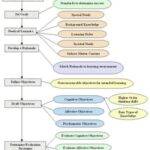The American educational system gains much of its prominence and strength partly because of its rich diversity of students. There are many positive advantages of diversity in the classroom, as well as the challenges it brings to educators. There are benefits society has received by including students of other cultures, races, religions, and learning styles. Diversity in the classroom has led to an increased understanding of other cultures, and brought about change in how teachers present information. (Dozier 252)
It is imperative that teachers be educated adequately and prepared to take on the challenges of today’s increasingly diverse classrooms. Teachers must be prepared to teach new, challenging standards to students with differing learning styles and cultural backgrounds. Schools can’t have a set of standards for children going to college while neglecting the rest of the student body. All children deserve a challenging education.
One of the elements that make our nation unique is our enormous cultural diversity that exists in abundance in today’s schools. This diversity should be viewed as an educational resource, not a problem. Every student brings his or her values, interests, and traditions into the classroom. The education and experiences that children bring into the classroom are valuable and it is essential that teachers facilitate their instruction around those differences.
Confirmation
College education, teacher training, in-service workshops, and professional development all stress the need for teachers to become facilitators in the classroom, ever-changing to varying student needs. This change from the traditional style of teaching is partly due to the growing amount of diversity in the classroom. Students come to school with different backgrounds and differing learning styles. It is essential that teachers take advantage of these differences and incorporate them into their teaching methods.
Additionally, teachers should strive to connect with each and every student. All children can learn, no matter where they come from. But one of the responsibilities of the teacher is to motivate them with a challenging curriculum that relates to them. It is essential that teachers first recognize the differences in their students. Only then can they ever hope to reach every student that passes through their door.
This is not an easy task, though, especially when most teachers see an average of 100 students per day. However, teachers should welcome the challenge of learning how their students learn, and how to transform their lessons to best meet their student’s needs. This may mean that teachers who once taught straight from the book will have to present ideas and information in new ways. Visual learners don’t learn best when reading text. On the contrary, some students may work best in groups, or at a computer. Teachers need to identify these differences. When they do, it will make a positive impact on all students.
Perceived Change
It is crucial to the success of any classroom to reach each and every student that enters the room. All too often, teachers cater to the needs of certain students while neglecting others. This is not done out of partiality or bias, but rather because of a lack of understanding in how to reach students with differing backgrounds. So many experienced educators tend to fall back on their “comfort zone” and choose to overlook that which is not understood.
In conclusion, the education system needs to understand the valuable resource of diversity. Students with differing backgrounds can bring so much to the classroom when teachers tap into that resource. These differences should not be a source of confusion, but one of opportunity. Students need to learn from each other. In addition, teaching styles need to adjust, or center on the learning styles and backgrounds of students. Rather than teach what one is comfortable with, educators should transform their curriculum (while still incorporating standards) using a variety of teaching styles to include all students. It is imperative that teachers take advantage of diversity by beginning to understand the backgrounds of their students, motivating each child with a challenging curriculum, and utilizing a variety of teaching methods in an effort to maximize every student’s learning potential.
Source:
Dozier, Therese. Using Our National Diversity as an Educational Resource.” The Social Studies, v88, 252-256, 1997.







